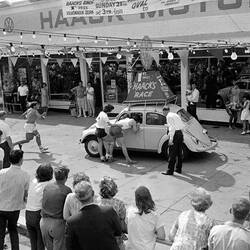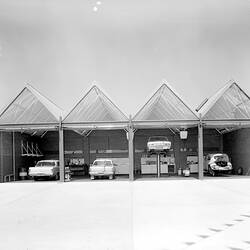Known as the Volkswagen (People's Car) this four-seat, rear-engined (air-cooled) light car was designed by Dr Ferdinand Porsche and Erwin Komenda in 1933-34 at the direction of Adolf Hitler who wanted an affordable car for the masses to accompany new autobahn construction. The design was heavily derivative of a previous rear-engine design project Porsche had completed for NSU as well as the streamlined Tatra T97. The rounded shape was compared to that of a beetle thus the origin of the car's nickname.
The prototype was finished in 1936. After testing of pre-production examples (known as KDF-Wagens) a new factory and model city (Stadt des KDF-Wagens) was opened by Hitler in 1938. German workers could, via the German Workers Front (DAF) subscribe to a savings scheme to purchase a KDF-Wagen by placing stamps in a booklet and then eventually redeem them for a car. Mass production of cars for civilian use was postponed due to the start of the Second World War in September 1939; however military versions of the KDF-Wagen, including the Type 82 Kubelwagen were manufactured for the German armed forces during the war. When the war ended in May 1945, the heavily damaged factory now known as Wolfsburg was taken over by the British Army which put the car into limited production for civilian use. Laurence Hartnett inspected the Volkswagen plant on behalf of the Australian government to determine if all or some of the machinery should be acquired for Australian use as war repartions. Hartnett rejected the production of the car in Australia and no equipment was removed.
Under private ownership and led by Heinz Nordhoff as Volkswagen AG, the 'Beetle' continued to rise in popularity as cheap and economical means of transport in the 1950s and early 1960s. Export sales rose sharply and the car became a symbol of the post-war economic recovery of West Germany and continued in production in West Germany until 1978. When production in Mexico ceased in 2003, over 21.5 million Beetles had been manufactured.
Apart from a couple of privately imported cars and two examples imported for examination by the Department of Munitions in 1947, the first Beetles were imported to Australia by Melbourne-based Regent Motors in late 1953. Volkswagen Australia was formed later by Regent Motors and other importers with majority shareholding owned by the German parent company. The firm brought in 'Completely Knocked Down' (CKD) car kits which were assembled in Melbourne with local content increasing over time. Volkswagen (Australasia) Pty Ltd was later wholly owned by the parent company.
Production of Volkswagen cars and commercial vehicles began at the Martin & King railway carriage factory at Clayton in Melbourne in 1959 and the plant expanded rapidly. However local production ceased in 1968, with just over 260,000 Beetles made, as competition from Japanese car imports progressively reduced sales. After 1968, production at Clayton reverted to CKD assembly of imported vehicles including some Japanese cars. The plant was then acquired by Nissan for production of Datsun cars. The last new Australian-assembled Beetle appeared in 1976.
The beetle was manufactured for a few more decades, however, sales continued to decline. Production of the unique and distinctive 'people's car' finally ceased in 2019.
References
Beetle: A brief history of a well-loved icon. accessed 14/1/2025.
Copping, Richard (2018), VW Beetle Specification Guide, 1949-1967, Crowood Press, United Kingdom.
More Information
-
Keywords
-
Localities
-
Authors
-
Article types
















